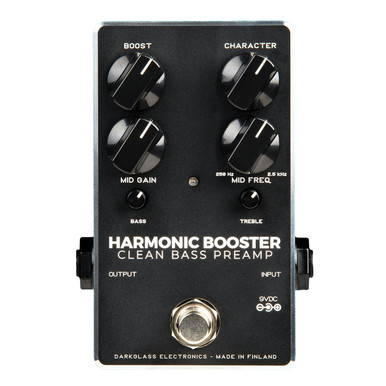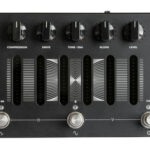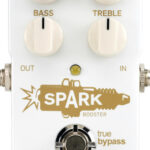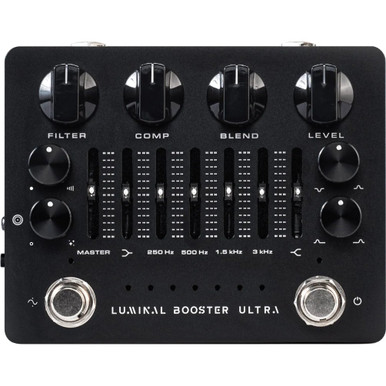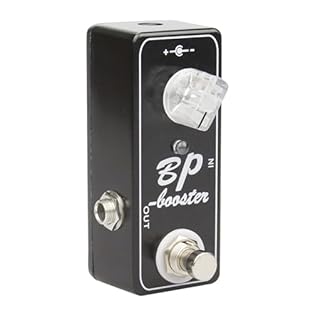Description
Darkglass Guitar Pedals are fresh in, this is a New one & the Just Pedals team think it is a very nice one too. Good news ! This can be delivered straight to your door, quickly and securely, anywhere in the UK & Europe. For more info on this New Guitar Pedals, please read on for full details, demos, videos, reviews and order online.
Darkglass Electronics are renowned for their high-gain distortion and fuzz stompboxes. However, before dabbling with the innovative Microtubes technology that is used in many of their current products, Darkglass launched the Harmonic Booster – their first ever pedal design. Heavily sought after, the Harmonic Booster is finally back and better than ever before!
Just like the original, the Darkglass Harmonic Booster 2.0 is primarily a clean preamp that offers plenty of tone-shaping potential with its 'Bass' and 'Treble' controls, and most notably – a sweepable parametric mid-range. Letting you find the sweet-spot, this flexible active EQ section as a whole offers mixing desk-level precision, especially in conjunction with the 'Character' control that allows you to determine how much of the EQ circuitry affects your core sound.
The 'Boost' knob delivers up to 20 dB cut/boost, but apart from simply affecting volume, the boost function also introduces extra harmonics to create a richer sound; akin to an exciter. The Darkglass Electronics Harmonic Booster 2.0 can therefore serve as an "always on" pedal that'll guarantee excellent tone no matter what you plug it into!
Here's what Darkglass Electronics says about the Harmonic Booster 2.0:
The original Harmonic Booster was Darkglass Electronics’ first ever pedal design. Now with the Harmonic Booster 2.0 the mythical product that started it all is back, but with major improvements over the original.
In the quest to design the perfect bass distortion, you first have to master the control of harmonics and filtering, which are crucial to sculpting the character and texture of a distortion circuit at will. It was when testing the first few gain and filter stages of what would later become the core of Darkglass’ overdrive technology, that it was realised that the harmonic excitation circuitry could yield amazing results on a clean signal at lower gain levels!
The result was a clean preamplifier that enhances attack and presence, while sculpting the mids for a very percussive and aggressive character and now rare examples of this early design are highly sought after. Darkglass Electronics has picked up a few tricks over the past decade, which translates into several improvements over the original design.
Aside from a new comprehensive EQ section for additional flexibility, noise performance and headroom are all vastly improved in V2.0. The unique tone-shaping engine can be controlled with the Character knob, which at minimum leaves your signal completely flat, providing absolute control from subtle to extreme enhancement. In addition, the new 3-band active equalizer, with bass and treble knobs, also features a semi-parametric mid control – a first for Darkglass!
Although Harmonic Booster 2.0 is designed to be the perfect complement to the line-up of Darkglass distortion circuits, its incredible flexibility and portability makes it the perfect one-stop solution for gigging musicians in search of a precise, yet harmonically rich clean preamplifier.
Features
- Clean Harmonic-Excitation Preamp
- Boost control – +/- 20 dB cut/boost
- 3 band Active EQ with Parametric Mid
- Character control – allows blending in the perfect amount of the tone-shaping circuitry
- Made in Finland
- Powered by regular 9V PSU (9V DC, centre -, 2,1 mm, ~30 mA current draw)
